Lincoln Electric CV320-I User Manual
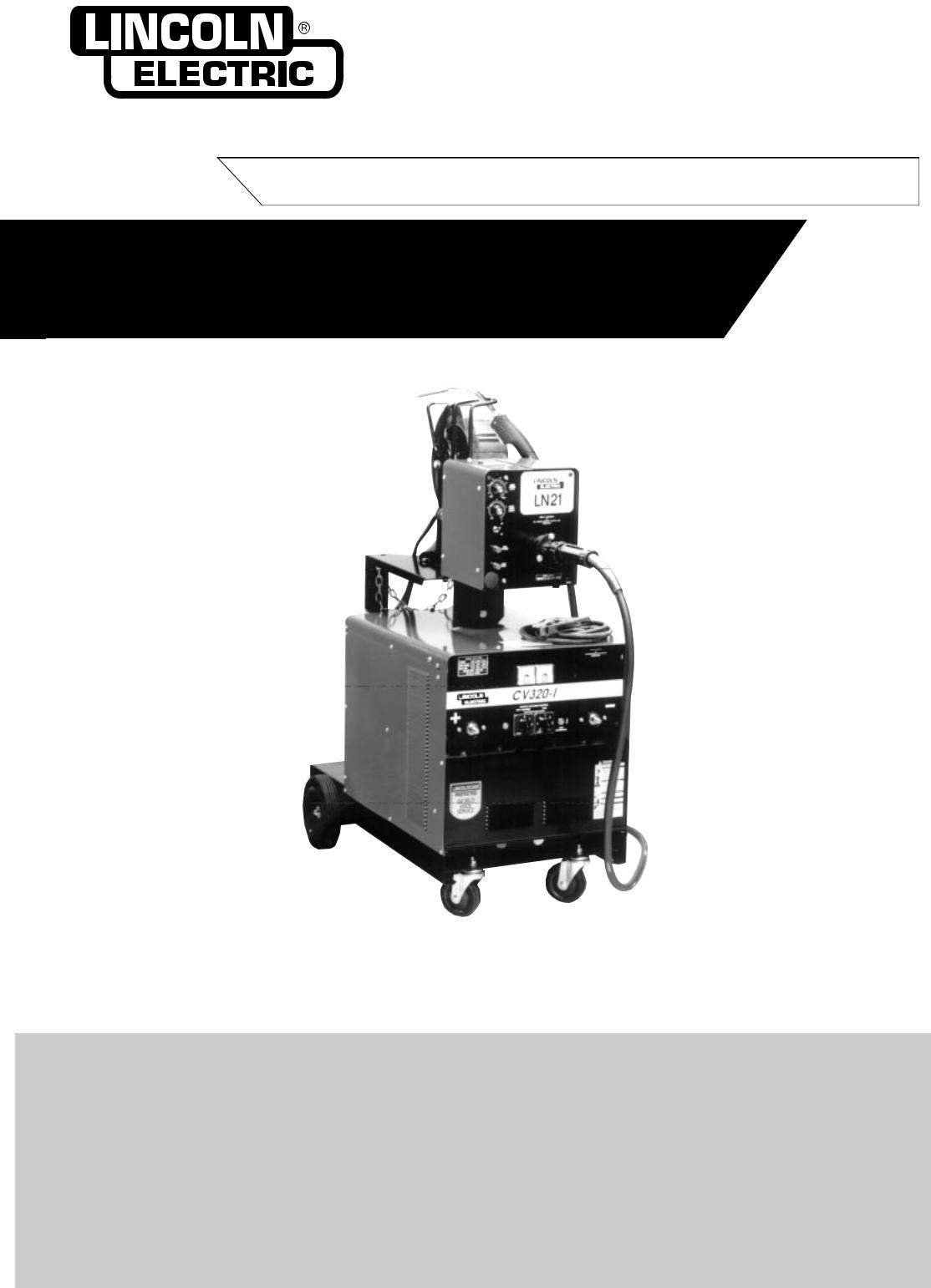
IMA 574B
OPERATING MANUAL
CV320-I
Semi automatic arc welding machine
This manual applies to
|
Part No. |
|
Code |
Desc |
Volts |
|
|
|
|||||
|
KA1392 |
|
1447 |
CV320-I |
415 |
|
|
KA1392-1 |
|
1473 |
CV320-I |
380 |
|
|
KA1392 |
|
1509 |
CV320-I |
415 |
|
|
KA1392-1 |
|
1510 |
CV320-I |
380 |
|
|
KA1392 |
|
1535 |
CV320-I |
415 |
|
|
|
|
|
|
|
|
SAFETY DEPENDS ON YOU
Lincoln Electric welders are designed and built with safety in mind. However, your overall safety can be increased by proper installation . . . and thoughtful operation on your part. Read and observe the general safety precautions on page 2 and follow specific installation and operating instructions included in this manual.
Most importantly, think before you act and be careful.
ACN 000 040 308
THE LINCOLN ELECTRIC COMPANY
(AUSTRALIA) PTY. LTD. A.C.N. 000 040 308
SYDNEY. AUSTRALIA
A Subsidiary of
THE LINCOLN ELECTRIC CO. U.S.A.
Associated Subsidiaries in Australasia, Europe, North and South America. THE WORLD’S LEADER IN WELDING AND CUTTING PRODUCTS
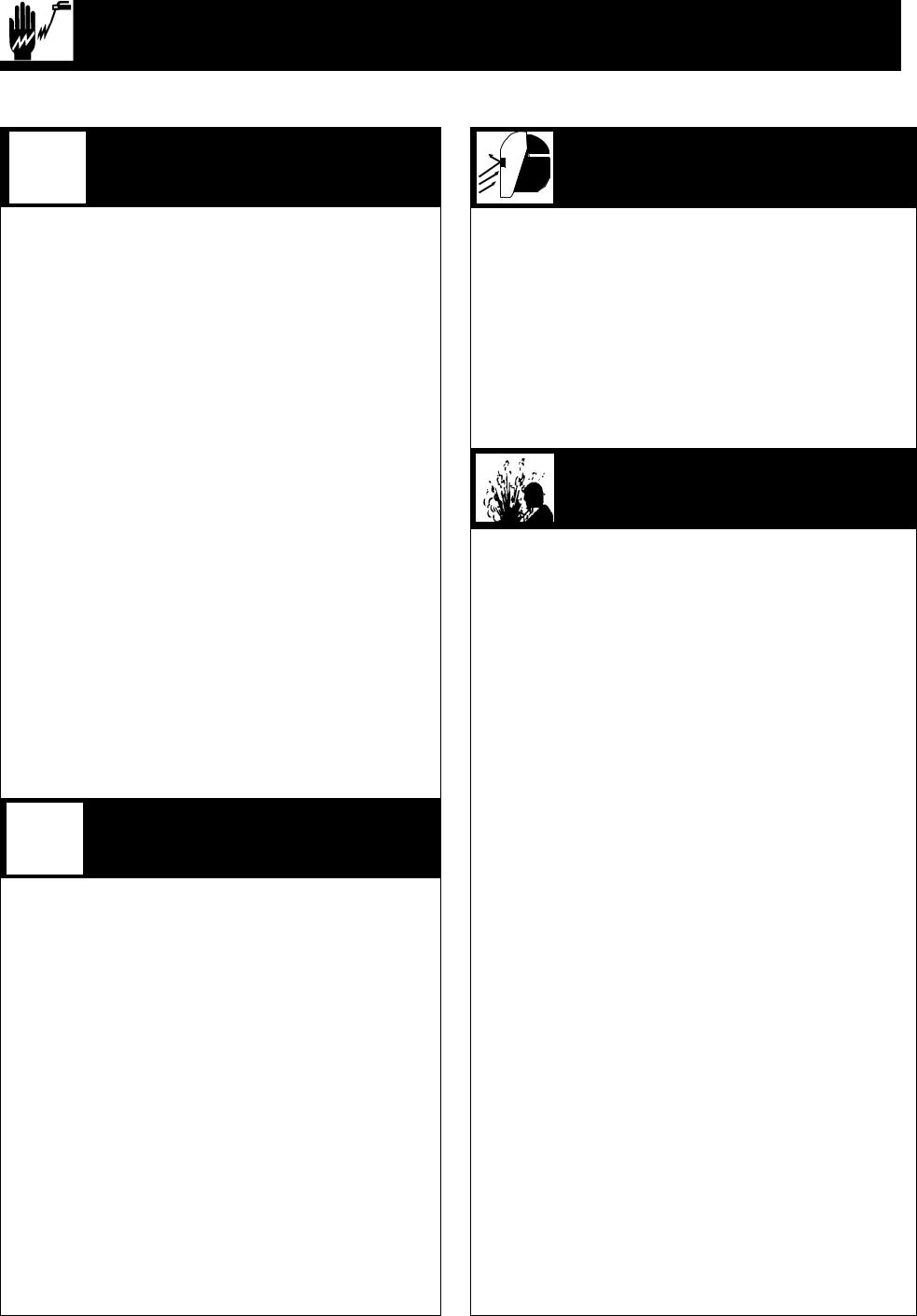
PROTECT YOURSELF AND OTHERS FROM POSSIBLE SERIOUS INJURY OR DEATH. READ AND UNDERSTAND
BOTH THE SPECIFIC INFORMATION GIVEN IN THE OPERATING MANUAL FOR THE WELDER AND/OR OTHER
EQUIPMENT TO BE USED AS WELL AS THE FOLLOWING GENERAL INFORMATION.
ARC WELDING SAFETY PRECAUTIONS
ELECTRIC SHOCK can kill |
ARC RAYS can burn |
1.a. The electrode and work (or ground) circuits are electrically “hot” when the welder is on. Do not touch these “hot” parts with your bare skin or wet clothing. Wear dry, hole-free gloves to insulate hands.
b.In semi-automatic and automatic wire welding, the electrode, electrode reel, welding head and nozzle or semi-automatic welding gun are also electrically “hot”.
c.Insulate yourself from work and ground using dry insulation. When welding in damp locations, on metal framework such as floors, gratings or scaffolds, and when in positions such as sitting or Lying, make certain the insulation is large enough to cover your full area of physical contact with work and ground.
d.Always be sure the work cable makes a good electrical connection with the metal being welded. The connection should be as close as possible to the area being welded.
e.Ground the work or metal to be welded to a good electrical (earth) ground.
f.Maintain the electrode holder, work clamp, welding cable and welding machine in good, safe operating condition. Replace damaged insulation.
g.Never dip the electrode holder in water for cooling.
h.Never simultaneously touch electrically “hot” parts of electrode holders connected to two welders because voltage between the two can be the total of the open circuit voltage of both welders.
i.When working above floor level, protect yourself from a fall should you get a shock.
j.Also see items 4c and 6.
2.a. Welding may produce fumes and gases hazardous to
FUMES AND GASES can be dangerous
health. Avoid breathing these fumes and gases. When welding, keep your head out of the fume. Use enough ventilation and/or exhaust at the arc to keep fumes and gases away from the breathing zone. When welding on galvanized, lead or cadmium plated steel and other metals which produce toxic fumes, even greater care must be taken.
b.Do not weld in locations near chlorinated hydrocarbon vapours coming from degreasing, cleaning or spraying operations. The heat and rays of the arc can react with solvent vapours to form phosgene, a highly toxic gas, and other irritating products.
c.Shielding gases used for arc welding can displace air and cause injury or death. Always use enough ventilation, especially in confined areas, to ensure breathing air is safe.
d.Read and understand the manufacturer’s instructions for this equipment and the consumables to be used, including the material safety data sheet (MSDS) and follow your employer’s safety practices.
e.Also see Item 7b.
3.a. Use a shield with the proper filter and cover plates to protect your eyes from sparks and the rays of the arc when welding or observing open arc welding. Headshield and filter lens should conform to AS 1674.2- 1990 standards.
b.Use suitable clothing made from durable flame resistant material to protect your skin and that of your helpers from the arc rays.
c.Protect other nearby personnel with suitable non flammable screening and/or warn them not to watch the arc or expose themselves to the arc rays or to hot spatter or metal.
WELDING SPARKS can cause fire or explosion
4.a. Remove fire hazards from the welding area. If this is not possible, cover them to prevent the welding sparks from starting a fire. Remember that welding sparks and hot materials from welding can easily go through small cracks and openings to adjacent areas. Have a fire extinguisher readily available.
b.Where compressed gases are to be used at the job site, special precautions should be used to prevent hazardous situations. Refer to AS1674 Parts 1 & 2 “Safety in Welding and Allied Processes”, WTIA Technical Note 7 “Health and Safety in Welding” and the operating information for the equipment being used.
c.When not welding, make certain no part of the electrode circuit is touching the work or ground. Accidental contact can cause overheating and create a fire hazard.
d.Do not heat, cut or weld tanks, drums or containers until the proper steps have been taken to insure that such procedures will not cause flammable or toxic vapours from substances inside. These can cause an explosion even though the vessel has been “cleaned”. For information purchase AS 1674-1990.
e.Vent hollow castings or containers before heating, cutting or welding. They may explode.
f.Sparks and spatter are thrown from the welding arc. Wear oil free protective garments such as leather gloves, heavy shirt, cuffless trousers, high shoes and a cap over your hair. Wear ear plugs when welding out of position or in confined places. Always wear safety glasses with side shields when in a welding area.
g.Connect the work cable to the work as close to the welding area as possible. Work cables connected to the building framework or other locations away from the welding area increase the possibility of the welding current passing through lifting chains, crane cables or other alternate circuits. This can create fire hazards or overheat lifting chains or cables until they fail.
h.Also see Item 7c.
Page 2 |
CV320-I |
IMA 574B |
|
|
|
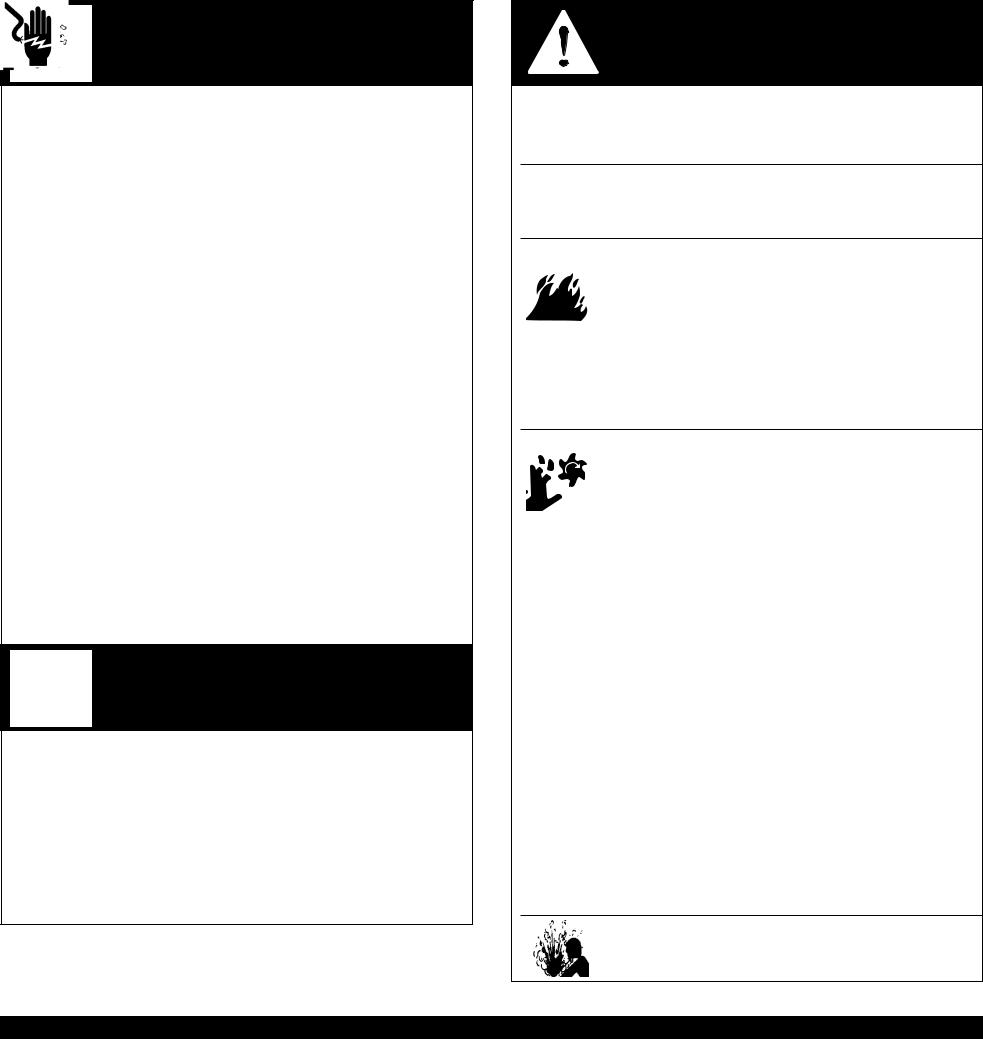
CYLINDER may explode if |
FOR ENGINE powered |
damaged |
equipment |
5.a. Use only compressed gas cylinders containing the correct shielding gas for the process used and properly operating regulators, designed for the gas and pressure used. All hoses, fittings, etc. should be suitable for the application and maintained in good condition.
b.Always keep cylinders in an upright position and securely chained to an undercarriage or fixed support.
c.Cylinders should be located :
•Away from areas where they may be struck or subjected to physical damage.
•A safe distance from arc welding or cutting operations and any other source of heat, sparks or flame.
d.Never allow the electrode, electrode holder, or any other electrically “hot” parts to touch a cylinder.
e.Keep your head and face away from the cylinder valve outlet when opening the cylinder valve.
f.Valve protection caps should always be in place and hand-tight except when the cylinder is in use or connected for use.
g.Read and follow the instructions on compressed gas cylinders and associated equipment, and AS 2030 Parts 1 & 2.
FOR ELECTRICALLY powered equipment
6.a. Turn off input power using the disconnect switch at the fuse box before working on the equipment.
b.Install equipment in accordance with the SAA Wiring Rules, all local codes and the manufacturer’s recommendations.
c.Ground the equipment in accordance with the SAA Wiring Rules and the manufacturer’s recommendations.
7.a.Turn the engine off before troubleshooting and maintenance work unless the maintenance work requires it to be running.
b.Operate engines in open, well ventilated areas or vent the engine exhaust fumes outdoors.
c.Do not add fuel near an open flame, welding
arc or when the engine is running. Stop the engine and allow it to cool before refuelling to prevent spilled fuel from vaporizing on contact with hot engine parts and igniting. Do not spill fuel when filling tank. If fuel is spilled, wipe it up and do not start engine until fumes have been eliminated.
d.Keep all equipment, safety guards, covers and devices in position and in good repair. Keep hands, hair, clothing and tools away from V-belts, gears, fans and all other moving parts when starting, operating or repairing equipment.
e.In some cases it may be necessary to remove safety guards to perform required maintenance. Remove guards only when
necessary and replace them |
when the |
maintenance requiring their removal |
is |
complete. Always use the greatest care when working near moving parts.
f.Do not put your hands near the engine fan. Do not attempt to override the governor or idler by pushing on the throttle control rods while the engine is running.
g.To prevent accidentally starting petrol engines while turning the engine or welding generator during maintenance work, disconnect the spark plug wires, distributor cap or magneto wire as appropriate.
h.To avoid scalding do not remove the radiator pressure cap when the engine is hot.
HAVE ALL INSTALLATIONS, OPERATION, MAINTENANCE AND REPAIR WORK PERFORMED BY QUALIFIED PEOPLE
For more detailed information it is strongly recommended that you purchase a copy of “Safety in Welding and Cutting - ANSI Standard Z 49.1” and WTIA Technical Note 7. All WTIA publications and ANSI/AWS Standards are available from the Welding Technology Institute of Australia, P.O. Box 6165, Silverwater NSW 2128. For copies of various Australian Standards contact your local S.A.A. office.
HOW TO ORDER REPLACEMENT PARTS
To ensure that you receive the correct replacement part the following procedure should be followed:
1.Quote Serial Number and Code Number.
2.Quote the Description, Item Number and Parts List Number of the desired part. When ordering parts for items carrying brand names of other companies, such as fan motors, drive shafts, etc., be sure to include the other company’s name and part number and other relevant information.
3.Should the primary cord be damaged, a special cord is required, and is available from Lincoln.
4.Parts should be ordered from Lincoln’s nearest authorised Field Service Shop. (The “Lincoln Service Directory” listing these shops geographically is available on request.)
NOTE: “Hardware” in the Lincoln Parts Lists are not Lincoln stock items but can be obtained via the Field Service Shop network. Component parts of assemblies such as stator coils or armature coils, etc., which require electrical testing or locating fixtures are not considered replaceable items. This is to ensure that the customer receives parts which will keep the welder in the best operating condition.
IMA 574B |
CV320-I |
Page 3 |
|
|
|

WELDING, EMF AND PACEMAKERS
All welders should follow safe practices that minimize their exposure to electric and magnetic fields (EMF).
For welders wearing implanted pacemakers, safe welding practices are particularly important and additional procedures should be followed by those who have decided to continue to weld. (Hopefully in keeping with a doctor’s advice).
The following procedures will not eliminate exposure to EMF or the possibility of arc welding having an effect on a pacemaker, however if followed, they will significantly reduce exposure to electric and magnetic fields. Electric and magnetic fields are created any time electric current flows through a conductor, however it is not clear whether such exposure affects ones health.
Some researchers have reported that exposure to EMF may cause leukemia or other illnesses. These claims originally arose in relation to high voltage electric power lines and are very much in dispute in the medical and scientific arena, however the best advice is to minimise your exposure to EMF to protect your health should doctors eventually decide there is a risk.
There are four fundamental fact about EMF:
•With direct current (DC), the field strength is relatively constant and does not change.
•With alternating current (AC), the field strength constantly changes.
•The greater the current flow, i.e. the higher the amps, the stronger the field created by the current
•The closer the conductor or electrical device is to the body, the greater the exposure to the field.
Minimising Exposure
All welders should use the following procedures to minimise EMF exposure.
•Route electrode or gun and work cables together. Secure them with tape if possible.
•Never coil the electrode lead around your body.
•Do not place your body between the electrode and work cables. If your electrode cable is on your right side the work cable should also be on your right side.
•Connect the work cable to the work piece as close as possible to the area being welded. (This is also a good practice to eliminate a common problem on welding - a poor work connection).
•Do not work next to the welding power source.
Welders with Pacemakers
There is no question that the fields in arc welding can interfere with a pacemakers function. Generally the interference does not permanently damage the pacemaker. Once the wearer leaves the arc welding environment or stops welding, the pacemaker returns to normal functioning. The welding arc has little or no effect on the operation of some pacemakers, especially designs that are bipolar or designed to filter out such interference.
For a welder or anyone working around electrical equipment the selection of a pacemaker is very important. Get a doctor’s advice about which pacemaker is the least sensitive to interference from welding while still being medically suitable.
In addition to the normal safety precautions, the following additional procedures should be adopted by welders with pacemakers.
•Use gas welding when the application is suitable.
•Use the lowest current setting appropriate for the application. Do not exceed 400 amps. Low current (75-200 amps) direct current (DC) welding should be used if arc welding is necessary. Do not TIG weld with high frequency.
•Do not use repeated, short welds. Wait about ten seconds between stopping one weld and starting the next. When having difficulty starting an electrode, do not re-strike the rod repeatedly.
•If you feel light headed, dizzy or faint, immediately stop welding. Lay the electrode holder down so that it does not contact the work and move away from any welding being performed. Arrange your work in advance so that, if you become dizzy and drop the electrode holder, the electrode holder will not fall on your body or strike the work.
•Do not work on a ladder or other elevated position or in a cramped, confined place.
•Do not work alone. Work only in the presence of an individual who understands these precautions and the possible effect welding may have on your pacemaker.
•Do not work near spot welding equipment.
•If you have a pacemaker and wish to continue arc welding, discuss this an any other questions you may have with your physician and follow his or her advice. The doctor may wish to contact the pacemaker manufacturer for a recommendation.
As mentioned before, the design of the pacemaker significantly affects the degree to which it is subject to interference from a welding circuit. Do not rely on the fact that you know another welder with a pacemaker who has welded for years without experiencing a problem. That welder and his or her pacemaker may be quite different from you and your pacemaker.
Page 4 |
CV320-I |
IMA 574B |
|
|
|

INSTRUCTIONS FOR ELECTROMAGNETIC COMPATIBILITY
WARNING
This welding machine must be used by trained operators only. Read this manual carefully before attempting to use the welding machine.
Conformance
Products displaying the C-Tick mark are in conformity with
Australian/New Zealand requirements for the Electromagnetic
Compatibility (EMC). They are:
•manufactured in conformity with Australian/New Zealand
Standard (Emission):- AS/NZS 3652 ‘Electromagnetic
Compatibility - Arc Welding Equipment’ (identical to and reproduced from, British Standard EN 50199).
•for using with other Lincoln Electric/LiquidArc equipment.
•designed for industrial and professional use.
Introduction
All electrical equipment generates small amounts of electromagnetic emission. Electrical emission may be transmitted through power lines or radiated through space, similar to a radio transmitter. When emissions are received by other equipment, electrical interference may result. Electrical emissions may effect many kinds of electrical equipment; other near by welding equipment, radio and TV reception, numerical controlled machines, telephone systems, computers, etc. Be aware that interference may result and extra precautions may be required when a welding power source is used in a domestic establishment.
Installation and Use
The purchaser/user is responsible for installing and using the welding equipment according to the manufacturer’s instructions. If electromagnetic disturbances are detected then it shall be the responsibility of the purchaser/user of the welding equipment to resolve the situation with the technical assistance of the manufacturer. In some cases this remedial action may be as simple as earthing (grounding) the welding circuit (see note below). In other cases it could involve constructing an electromagnetic screen enclosing the power source and the work complete with associated input filters. In all cases electromagnetic disturbances must be reduced to the point where they are no longer troublesome.
NOTE: The welding circuit may or may not be earthed for safety reasons according to national codes. Changing the earthing arrangements should only be authorised by a person who is competent to assess whether the changes increase the risk of injury, eg. by allowing parallel welding current return paths which may damage the earth circuits of other equipment.
Assessment of Area
Before installing welding equipment the purchaser/user shall make an assessment of potential problems in the surrounding area.
The following shall be taken into account:
a.Other supply cables, control cables, signalling and telephone cables; above, below and adjacent to the welding equipment;
b.Radio and television transmitters and receivers;
c.Computer and other control equipment;
d.Safety critical safety equipment, eg. guarding of industrial equipment;
e.The health of people around, eg. the use of pacemakers and hearing aids;;
f.Equipment used for calibration or measurement;
g.The immunity of other equipment in the environment. The purchaser/user shall ensure that other equipment being used in the environment is compatible. This may require additional protection measures;
h.The time of the day that welding or other activities are to be carried out.
The size of the surrounding area to be considered will depend on the structure of the building and other activities that are taking place. The surrounding area may extend beyond the boundaries of the premises.
Methods of Reducing Emissions
Mains Supply
Welding equipment should be connected to the mains supply according to the manufacturers recommendations.If interference occurs, it may be necessary to take additional precautions such as filtering the mains supply. Consideration should be given to shielding the supply cable of permanently installed welding equipment, in metallic conduit or equivalent. Shielding should be electrically continuous throughout its length. The shielding should be connected to the welding power source so that good electrical contact is maintained between the conduit and the welding power source enclosure.
Maintenance of the Welding Equipment
The welding equipment should be routinely maintained according to the manufacturer’s recommendations. All access and service doors and covers should be closed and properly fastened when the welding equipment is in operation. The welding equipment should not be modified in any way except for those changes and adjustments covered in the manufacturers instructions. In particular, the spark gaps of arc initiation and stabilising devices should be adjusted and maintained according to the manufacturer’s recommendations.
Welding Cables
The welding cables should be kept as short as possible and should be positioned close together, running at or close to the floor level.
Equipotential Bonding
Bonding of all metallic components in the welding installation and adjacent to it should be considered. However, metallic components bonded to the work piece will increase the risk that the operator could receive a shock by touching these metallic components and the electrode at the same time. The operator should be insulated from all such bonded metallic components.
Earthing of the Workpiece
Where the workpiece is not bonded to earth for electrical safety, nor connected to earth because of its size and position, eg. ship’s hull or building steelwork, a connection bonding the workpiece to earth may reduce emissions in some, but not all instances. Care should be taken to prevent the earthing of work pieces increasing the risk of injury to users, or damage to other electrical equipment. Where necessary, the connection to the workpiece to earth should be made by direct connection to the workpiece, but in some countries where direct connection is not permitted, the bonding should be achieved by suitable capacitance, selected according to national regulations.
Screening and Shielding
Selective screening and shielding of other cables and equipment in the surrounding area may alleviate problems of interference. Screening of the entire welding installation may be considered for special applications.*
*Portions of the preceding text are contained in AS./NZS3652: ‘Electromagnetic Compatibility - Arc Welding Equipment’.
IMA 574B |
CV320-I |
Page 5 |
|
|
|
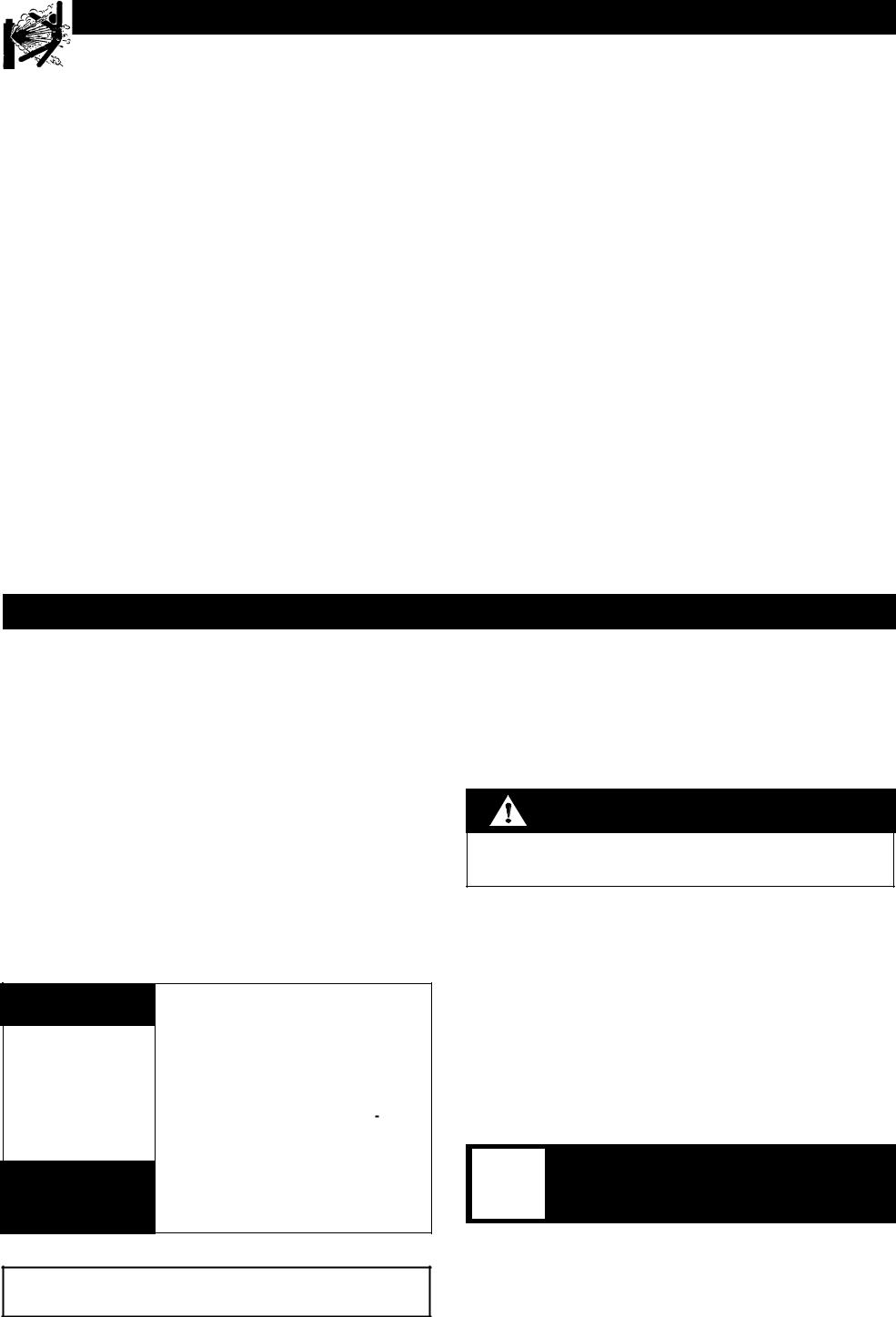
PRODUCT DESCRIPTION
The CV320-I is a semi-automatic Constant Voltage DC arc welding power source and wire feeder. It combines a step controlled power source with a separate solid state controlled wire feeder.
Excellent arc characteristics are provided for both gas shielded and self shielded welding within its current range.
For instructions on operation of the wire feeder refer to the separate instruction manual included. Standard features include output volt & amp meters, a spot timer, gas purge facilities, a dual position 2 or 4 step trigger interlock, a Magnum FM400 gun, a regulator/flowmeter and gas hose, a 10m electrode cable and wire feeder cable, a 3m ground cable assembly, a 3m long input lead and an undercarriage on which a gas cylinder can be mounted.
Specifications
Part No. |
|
KA 1392 & KA1392-1 |
|
||
|
|
|
|
|
|
Maximum Open Circuit Voltage |
|
45V |
|
|
|
|
|
|
|
|
|
Output Current Range |
|
20 to 400A |
|
||
|
|
|
|
|
|
Duty Cycle |
30% |
60% |
|
100% |
|
|
|
|
|
|
|
Rated Output |
320A/30V |
240A/26V |
190A/23.5V |
||
|
|
|
|
|
|
Rated Input |
KA1392 415V 3ph 50Hz 13.5 amps |
|
KA1392-1 380V 3ph 50hz 14.7amps |
||
|
|
|
|
|
|
Wire Speed Range |
|
1-20 m/min |
|
||
|
|
|
|
|
|
Weight (complete with u/c) |
|
140 kg |
|
|
|
|
|
|
|
|
|
H x W x L (mm) Over wire feeder, |
|
1220 x 580 x 842 mm |
|
||
cylinder tray & wheels |
|
|
|||
|
|
|
|
|
|
|
|
|
|
|
|
Operating Temperature |
|
-20˚C to 40˚C |
|
||
|
|
|
|
|
|
INSTALLATION
Location
Place the welder where clean cooling air can freely circulate in through the intake louvers and out through the exhaust louvers. Dirt, dust or any foreign material that can be drawn into the welder should be kept at a minimum. Failure to observe these precautions can result in excessive operating temperatures and nuisance thermostat trips.
Wire Feeder Mounting
Locate the control cable at the rear of the CV320-I and plug into the wire feeder. The control cable is already connected to the CV320-I. Connect the supplied 1.5m electrode cable to the wire feeder mechconnector and to the desired polarity terminal on the front of the CV320-I.
 WARNING
WARNING
HIGH
VOLTAGE can kill
•Turn the input power off at the disconnect switch before installing or servicing this machine.
•Do not touch electrically “hot” parts such as output terminals or internal wiring.
•Connect grounding screw ( ) to a good earth ground.
) to a good earth ground.
•Do not operate with covers removed.
•Turn power switch “off” before connecting or disconnecting cables or other equipment.
Only qualified personnel should install or service this equipment.
Connection to Mains Supply
Before connecting the machine to the mains supply check that the voltage and current capacity correspond to the machine voltage and rated input current. Use a fuse or C/B per AS3000 or local wiring rules.
The machine is supplied with an input lead fitted. Have a qualified electrician fit a suitable input plug.
CAUTION
Never connect the green/yellow conductor to any of the three active supply lines from the mains. This conductor is to earth the machine as required by Electrical Regulations.
Once the above has been followed the machine can be plugged into the mains outlet.
Shielding Gas Supply
(For the Gas Metal Arc Welding Process)
Refer “Safety in Welding and Cutting” - ANSI Standard Z49.1 and
WTIA Technical Note 7, available from the Welding Technology Institute of Australia.
Obtain cylinder of appropriate type shielding gas for the process being used.
1.Set gas cylinder on rear platform of the machine. Hook chain in place to secure cylinder to rear of welder.
CYLINDER may explode if damaged
2.Remove the cylinder cap. Inspect the cylinder valve for damaged threads, dirt and dust. For cylinders having an external thread fitting, remove any dust and dirt from the threads with a clean cloth.
Page 6 |
CV320-I |
IMA 574B |
|
|
|
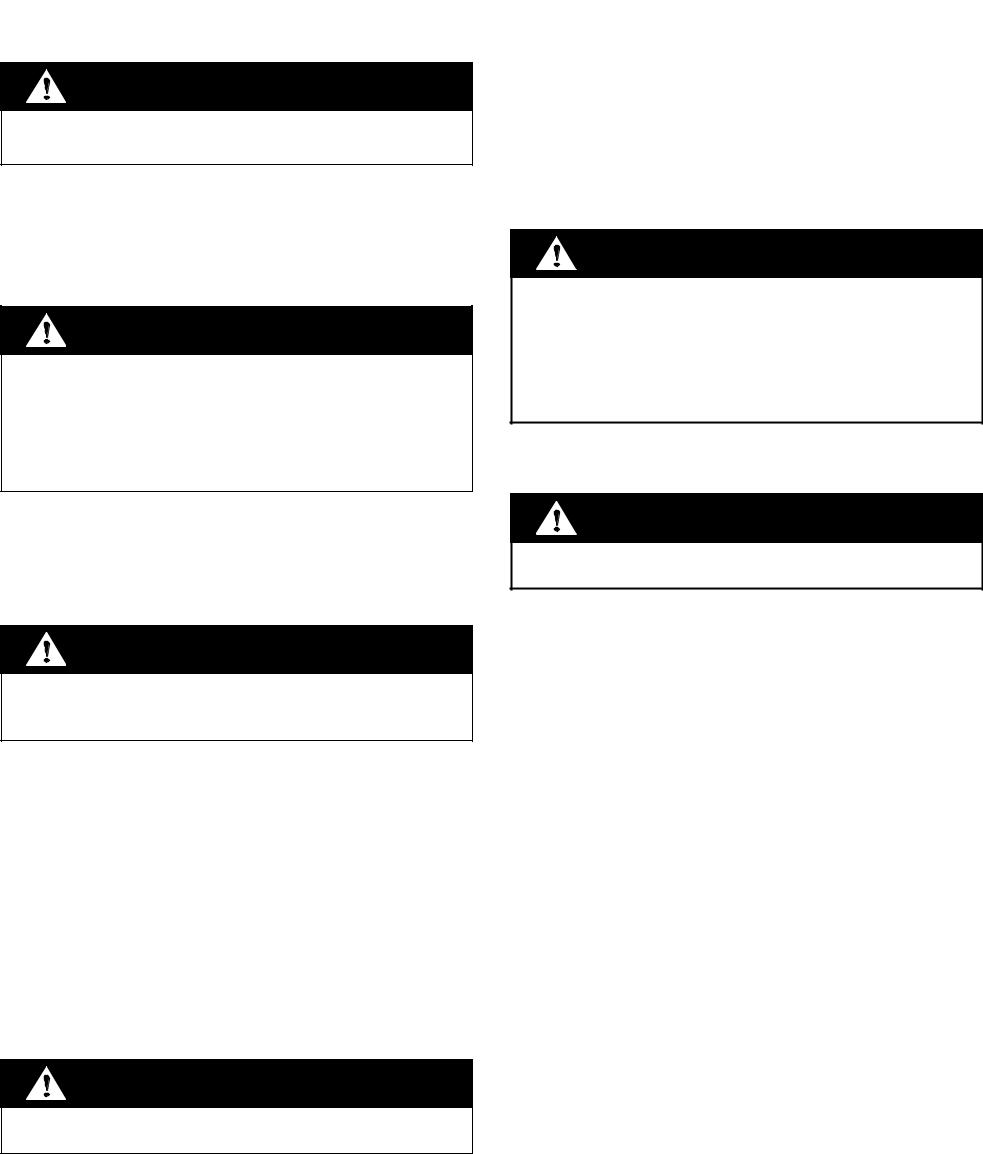
DO NOT ATTACH THE REGULATOR/FLOWMETER IF
CYLINDER VALVE IS DAMAGED! Inform your gas supplier of this condition.
3.Stand to one side away from the outlet and open the cylinder valve for an instant. This blows away any dust or dirt which may have accumulated in the valve outlet.
WARNING
Be sure to keep your face away from the valve outlet when “cracking” the valve.
4.Inspect the regulator/flowmeter for damaged threads and seals, dirt and dust. Remove dust and dirt with a clean cloth.
DO NOT USE THE REGULATOR/FLOWMETER IF DAMAGE
IS PRESENT! Have an authorised repair station repair any damage.
WARNING
Gas under pressure is explosive. Always keep gas cylinders in an upright position and always keep chained to undercarriage or stationary support. Refer “Safety in Welding and Cutting” - ANSI Standard Z49-1 and WTIA Technical Note 7 available from the Welding Technology Institute of Australia.
5.Attach the regulator/flowmeter to the cylinder valve and tighten the union nut(s) securely with a spanner.
6.Attach the inlet gas hose to the outlet fitting of the regulator/flowmeter, and tighten the union nut securely with a spanner.
WARNING
Never stand directly in front of or behind the regulator/flowmeter when opening the cylinder valve. Always stand to one side.
7.Before opening the cylinder valve, turn the regulator adjusting knob counter-clockwise until the adjusting spring pressure is released.
8.Open the cylinder valve slowly a fraction of a turn. When the cylinder pressure gauge pointer stops moving, open the valve fully.
9.The regulator/flowmeter is adjustable. Set it for the flow rate recommended for the procedure and process being used before starting to weld.
Gun and Cable
The Magnum FM400 gun and cable provided with the machine is set up for 0.9/1.2mm operation.
1.Lay the cable out straight.
WARNING
Turn the welder power switch off before installing gun and cable.
2.Make sure all pins on the gun cable connector are aligned with the proper mating sockets on the front panel gun connector and then join the connectors and tighten the hand nut on the gun cable connector.
NOTE: If a gun and cable other than the Magnum FM400 gun are to be used, they must conform to standard European-style connector specifications. See diagram under.
The gun trigger switch must be capable of switching 10 milliamps at 60 volts DC—resistive.
CAUTION
The gun trigger switch connected to the gun trigger control cable must be a normally open, momentary switch. The terminals of the switch must be insulated from the welding circuit. Improper operation of, or damage to, the machine might result if this switch is common to an electrical circuit other than the machine trigger circuit.
Output Polarity Connection
WARNING
Turn the welder power switch off before changing output connection.
Connect the lead from the wire feeder to the output stud of the desired polarity.
Connect the work lead to the other output stud.
IMA 574B |
CV320-I |
Page 7 |
|
|
|
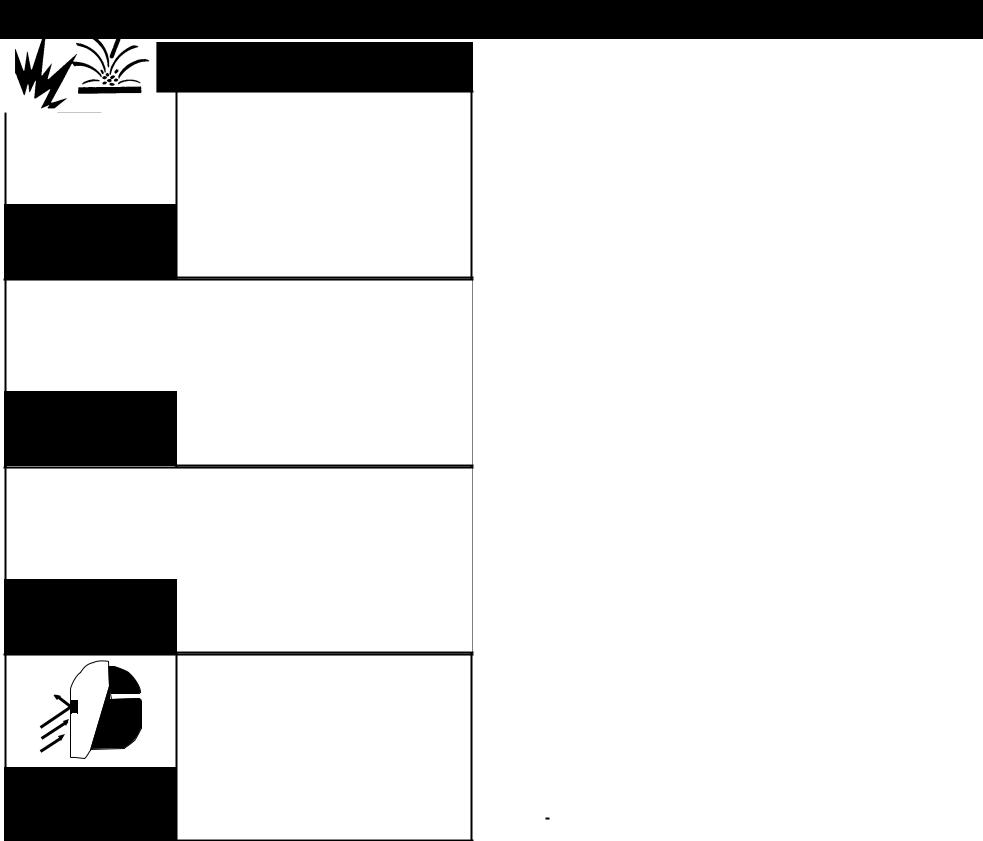
OPERATING INSTRUCTIONS
WARNING
•Do not touch electrically live parts or electrode with skin or wet clothing.
•Insulate yourself from work and ground.
ELECTRIC • Always wear dry insulating gloves.
SHOCK can kill
•Keep your head out of fumes.
•Use ventilation or exhaust to remove fumes from breathing zone.
FUMES AND GASES can be dangerous
•Keep flammable material away.
•Do not weld upon containers which have held combustibles.
WELDING SPARKS can cause fire or explosion
• Wear eye, ear and body protection.
ARC RAYS can burn
IMPORTANT SAFETY NOTE: In 2T mode, this DC Constant Voltage wire welder provides “COLD” electrode when the gun trigger is not operated. Conversely, the output terminals are
“LIVE” when the gun trigger is “activated” when pressed in 2T mode, or triggered on in 4T mode.
Refer to wire feeder manual for a description of the 2T/4T trigger operation.
Duty Cycle
The machine is rated at the following duty cycles:
Duty Cycle* |
Output Amps |
Arc Volts |
|
|
|
30% |
320 |
30 |
|
|
|
60% |
240 |
26 |
|
|
|
100% |
190 |
23.5 |
|
|
|
*Based on 10 min. time period (i.e., for 60% duty cycle, it is 6 minutes actual welding and 4 minutes with no welding output, but with the input power remaining on keeping the cooling fans operative.)
Control Panel
Power Switch
The mains power switch is incorporated in the “coarse” output voltage control rotary switch. In the “0” position (fully counter clockwise) the input mains power is switched off.
Pilot Light
This light illuminates when the input mains power is switched on
Volts Control
The output voltage is controlled by two rotary switches. One rotary switch provides four “coarse” voltage settings as well as switching the mains power on. The other rotary switch provides the user with a selection of eight “fine” voltage settings. The selection between these two rotary switches allows the user to select any one of thirty-two welding voltages.
The approximate weld voltages for the rotary switch positions are:
|
|
|
|
|
|
|
Coarse |
Fine |
Volts |
Coarse |
Fine |
Volts |
|
|
|
|
|
|
|
|
1 |
1 |
13.0 |
2 |
1 |
18.0 |
|
1 |
2 |
14.0 |
2 |
2 |
18.5 |
|
1 |
3 |
15.0 |
2 |
3 |
19.0 |
|
1 |
4 |
16.0 |
2 |
4 |
19.5 |
|
1 |
5 |
16.5 |
2 |
5 |
20.0 |
|
1 |
6 |
17.0 |
2 |
6 |
20.5 |
|
1 |
7 |
17.5 |
2 |
7 |
21.0 |
|
1 |
8 |
18.0 |
2 |
8 |
21.5 |
|
|
|
|
|
|
|
|
3 |
1 |
21.5 |
4 |
1 |
25.0 |
|
3 |
2 |
22.0 |
4 |
2 |
25.5 |
|
3 |
3 |
22.5 |
4 |
3 |
26.0 |
|
3 |
4 |
23.0 |
4 |
4 |
26.5 |
|
3 |
5 |
23.5 |
4 |
5 |
27.0 |
|
3 |
6 |
24.0 |
4 |
6 |
28.0 |
|
3 |
7 |
24.5 |
4 |
7 |
29.0 |
|
3 |
8 |
25.0 |
4 |
8 |
30.0 |
|
|
|
|
|
|
|
|
Current Control
Use the wire feed speed control on the wire feeder to adjust the speed at which the electrode wire feeds when welding. This is in effect a current control as the power source will deliver the current necessary to melt the wire. The higher the speed, the more current will be required.
Over temperature light
Indicates that the thermostats have operated to protect unit from over temperature.
Setting Up for Welding
(Also refer to the wire feeder instruction manual.)
The following items are required:
1)A reel of wire of suitable size and type .
2)A suitable gun and cable assembly with a “Euro” connector and the correct tip and, if necessary gas nozzle for the consumable being used. (A Magnum FM400 gun is supplied).
3)A work return cable and clamp. (supplied)
4)Normal welding accessories including helmet or hand shield with suitable lens, gloves etc.
5)If a gas shielded process is to be used, a cylinder of appropriate gas is required. (Regulator/flowmeter and hose are supplied.)
Page 8 |
CV320-I |
IMA 574B |
|
|
|
